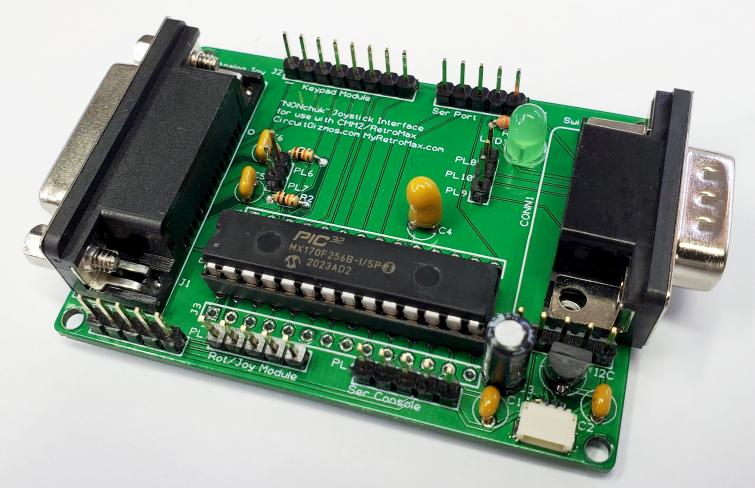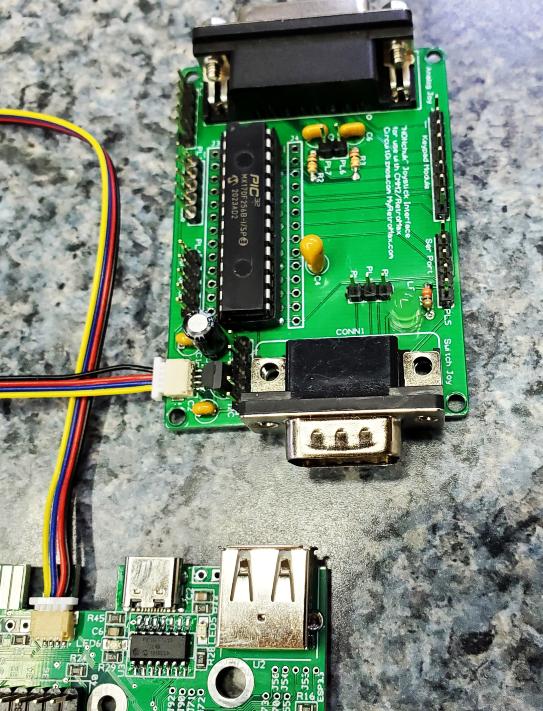
|

|
Forum Index : Microcontroller and PC projects : Joystick interface board
| Author | Message | ||||
CircuitGizmos Guru Joined: 08/09/2011 Location: United StatesPosts: 1427 |
I mentioned in a thread that scrolled somewhere off page that I would make a joystick adaptor board for the CMM2 (or other uses) for Atari and PC (analog) joysticks. I jokingly called it the NONchuk and that name just stuck. The NONchuk board provides a way to interface joysticks and other devices to the RetroMax. The intention is to use the I2C port on the NONchuk to connect to the Nunchuk interface on the RetroMax (or CMM2). The NONchuk allows the Nunchuk port of the RetroMax to connect to joysticks and several other devices. Since there are a variety of different devices that can be connected, the NONchuk uses a MicroMite chip (the '170 with MMBasic installed) to run code for the task. The NONchuck has a console port that can be used as the serial interface for programming the MMBasic code specific to how the NONchuk will be used.  The NONchuk features: Based on MMBasic '170 so it can be user re/programmed Support Atari (digital/switch) joystick Support PC (analog/potentiometer) joystick Operate as I2C slave interface Operate as serial interface Support 16 key keypad Support rotary module Support analog joystick module The NONchuck board could also be used as a stand-alone MicroMite ('170 chip) board. For example it could be used with a joystick and various pins from the microcontroller could control relays, LEDs, etc. The NONchuk has an on-board 3.3V regulator if the source power for the board is 5V. The board will work from either 5V or 3.3V. The MicroMite on the board runs at 3.3V. If 3.3V is present to the board the power LED will illuminate. Power and ground connections can be found on several of the connection points. On either side of the NONchuk microcontroller (MicroMite) are a row of connections that connect one to one to the 28 pins of the MicroMite. These provide simple/easy access to all of the MicroMite pins. Buy the NONchuk PCB here: CircuitGizmos or assembled here: Tindie Documentation here: NONchuk documentation Micromites and Maximites! - Beginning Maximite |
||||
CircuitGizmos Guru Joined: 08/09/2011 Location: United StatesPosts: 1427 |
Here is the new Gen 2 version of the RetroMax connected to the NONchuk board via the QWIIC connection. The RetroMax would access the NONchuk via I2C. The NONchuk board would be running its own program (micromite) interpreting joysticks or keypads or even digital/analog sensors.  Micromites and Maximites! - Beginning Maximite |
||||
| vegipete Guru Joined: 29/01/2013 Location: CanadaPosts: 1154 |
Neat board but J1 and CONN1 on opposite ends makes it a pain to mount on a panel. I gather when it is used as an I2C slave, the address is set entirely by _software_ running on the '170? (Although spare pins could be used, by software, to set the address, or a bit or two of the address?) Atm, all images on <https://docs.myretromax.com/NONchuk_joystick_interface.html> link to the page itself, not a larger version of the image. Visit Vegipete's *Mite Library for cool programs. |
||||
CircuitGizmos Guru Joined: 08/09/2011 Location: United StatesPosts: 1427 |
> Neat board but J1 and CONN1 on opposite ends makes it a pain to mount on a panel. Never gave that a thought, mainly because I was thinking more of either analog or digital, not both. Perhaps a panel mount 9 pin socket (solder cups) could be used in place of the PCB mount one. > I gather when it is used as an I2C slave, the address is set entirely by _software_ running on the '170? (Although spare pins could be used, by software, to set the address, or a bit or two of the address?) Yes. > Atm, all images on <https://docs.myretromax.com/NONchuk_joystick_interface.html> link to the page itself, not a larger version of the image. That seems to be a limit of my note software. I'll have to edit the pages with better links next time I make changes. Micromites and Maximites! - Beginning Maximite |
||||
| The Back Shed's forum code is written, and hosted, in Australia. | © JAQ Software 2025 |